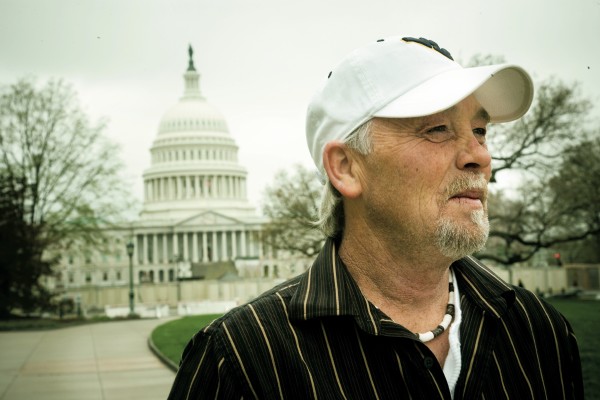Chuck Nelson needs a smoke. He lights a Marlboro while steering his Mitsubishi Eclipse along the winding roads of West Virginia’s coalfields. A slight man with a raspy voice, Nelson spent 30 years working underground in the mines. He drives fast because he’s late and because these roads course through him like veins. He’s lived in these mountains since he was born.
In this part of Appalachia, there are no luxury condos. It’s mostly trailers and rundown houses with pickup trucks out front.
The coal industry has nearly taken over these hills, and at times it feels as if you’ve left America. Along Route 3, Nelson points to one industrial complex after the next, each with tubes snaking up and down the hillside—they’re preparation plants where coal is washed before it’s shipped to power plants. He points to dozens of onyx-colored pyramids, piles of coal as tall as buildings.
“See that ridge up there?” Nelson says. “On the other side of that, the coal companies are blasting every day. Blasting the mountains right off.”
After hearing that people in a nearby town were getting sick, possibly from coal waste in their water, Nelson and others started taking samples from their wells. The samples, a dozen Mason jars containing different-colored liquids, are in his trunk. One looks like coffee with cream, another like iced tea.
Nelson thought he’d stop thinking about coal when he retired from the mines. He thought he’d keep quiet after a coal company bought his home to appease him; so much dust had been blowing into his house from a nearby prep plant that Nelson’s asthmatic wife couldn’t breathe. But he can’t stay quiet. In his mind, coal is destroying the communities it used to lift up.
He asks: “How many people in other states, when they go to flip on their light switch, stop and think: Where’s this power coming from, and what is the true cost of it?”
Until a storm knocks out power, we take for granted that a steady stream of electricity will keep Washington humming. But power has to come from somewhere, and in our region about half of it comes from coal-burning power plants.
Coal-fired electricity has gained popularity because it’s the most reliable and least expensive source on the grid. The rising cost of natural gas makes gas-fired power plants unpopular. No nuclear-power plant has been built since the 1979 meltdown at Three Mile Island in Pennsylvania.
According to the National Mining Association, the United States has more than 265 billion tons of recoverable coal reserves, enough to last for 240 years at today’s usage rates.
“We refer to ourselves as the Saudi Arabia of coal—we actually possess more coal reserves than all of the Middle East has oil,” says Kraig Naasz, president of the National Mining Association. “It’s the advantage the US has over the rest of the world.”
But climate scientists have a problem with coal-fired power plants: The planet is warming in part because of their CO2 emissions. According to the Sierra Club, coal emits about 40 percent of the nation’s carbon emissions—carbon is the prime global-warming pollutant—second only to petroleum. If all of the planned coal plants are built, that will increase carbon emissions by 15 percent.
Environmentalists aren’t the only ones fighting coal. Residents of Old Town Alexandria are hoping to shut down an aging coal-fired power plant that they say sprinkles soot onto their balconies and sends pollutants into their lungs. Residents of Wise County, Virginia, are fighting to stop construction of a planned coal plant.
But what would Washington do without coal? The area’s population is growing. All those new houses, flat-screen televisions, and laptops need power. The West Virginia Coal Association says the average Internet user, online 12 hours a week, uses 300 pounds of coal every year.
According to Naasz, by 2030 the nation’s electricity needs will increase by nearly 30 percent. To keep up with demand, he says, we’re going to need more coal-fired power plants.
If Chuck Nelson followed the coal leaving West Virginia, he might end up in Washington. Most of the Washington area’s six coal-fired power plants burn coal from West Virginia. Coal from the southern part of the state is low in sulfur dioxide, making it easier for plants to meet pollution controls. The coal is shipped in on trains, sometimes 50 or more railcars long.
“It’s hard trying to get everyone to understand that the people in New York and Baltimore and DC could not conduct their daily lives without the coal miner in West Virginia,” says Bill Raney, president of the West Virginia Coal Association.
The spike in oil prices has helped increase demand for coal. In the past three years, spot-market prices for Appalachian coal have risen from between $50 and $60 a ton to more than $100. Some companies have reduced underground mining production, and the industry is using more-efficient computerized equipment, which has reduced the number of miners.
In 1952, more than 100,000 people were employed by West Virginia’s coal industry; in 2006, about 20,500 were. As a result, residents say their towns are disappearing. Most storefronts in Nelson’s hometown of Whitesville are empty.
The Appalachian coal industry is increasingly turning to mountaintop mining, which critics call “mountaintop removal.” Miners strip trees from mountains, blast open peaks, dump the waste into valleys, and excavate the coal seams using a bucket large enough to hold more than 20 compact cars.
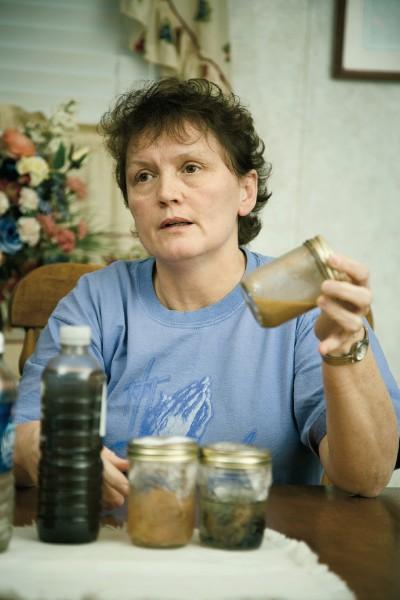
“The method of mining is dictated by the geology,” says Raney. “The coal seams are in the upper horizons of the natural geology and topography in the state—you can’t underground those seams.” ➝
Coal companies have been mining mountaintops since the 1970s; the National Mining Association says the method now accounts for about 10 percent of US coal production. During the Clinton years, says West Virginia University political-science professor Richard Brisbin, “people were just beginning to realize the nature of the injury.”
Citizens’ groups had started taking legal action, Brisbin says, but their efforts were complicated by eased restrictions during the Bush administration. In 2002, the Environmental Protection Agency and the US Army Corps of Engineers redefined two words in the Clean Water Act of 1977—“fill material.” The definition had previously excluded waste disposal. The rule change, first proposed by the Clinton administration, would allow fill material to include mining waste, which meant coal companies could now legally dump debris from mining sites into streams.
Mountaintop mining is cheaper than underground—it requires fewer workers and maximizes the recovery of coal. According to EPA estimates, more than 470 mountains in Appalachia have been destroyed along with 1,200 miles of streams. Every year, millions of pounds of explosives are set off in the mountains there, and the blasts are so powerful that residents say they can knock houses off their foundations.
Some coalfield residents are moving away. “They’re losing that connection to where they’re from—that connection to belonging to these mountains,” says George Davis, a Marshall University assistant professor researching citizen movements in Appalachia.
Lots of people in Appalachia are hesitant to speak out. Nearly everyone knows someone who works for a coal company, and people have lost their jobs by objecting. But as health concerns grow and jobs slip away, more residents are raising their voices.
Says waitress turned activist Maria Gunnoe: “We’re the people being sacrificed—our water, our land, our air—in the name of energy across the country.”
“All We Want Is Clean Water”
Nelson pulls up to his friend Maria Lambert’s house, a mobile home with yellow vinyl siding. A gurgling creek runs in front.
Lambert lives in Seth, about 30 miles south of the state capital, Charleston, and two hours west of the Greenbrier resort. She’s a few miles from a mountaintop-mining operation, in a hollow off Prenter Road. Her parents and grown son have mobile homes next to hers. For about a year, she and her husband, Ralph, a disabled miner, heard blasting every day around 4 o’clock.
On a snowy morning in January when she opens the door to her home—where she spends days playing with her four-year-old granddaughter—Lambert explains the odor. “We both took a shower this morning,” she says. “That’s what that is—it’s our water.”
Lambert was raised in a coal camp called Prenter. Her father worked 25 years in the mines before he retired at age 42, sick with black-lung disease. She once had a job at the camp’s company store, making sandwiches for miners. Now her 29-year-old son makes his living driving a coal truck.
That hasn’t stopped Lambert from talking about her belief that coal waste buried underground has seeped into her water. She and Ralph get their drinking water from a well behind their house because the city water lines don’t reach them. They’re convinced it’s making them sick.
Today Lambert has set out photographs on her living-room table—pictures of discolored bathtubs and toilets, rusted hot-water heaters. She’s helping organize community meetings and writing to politicians.
Until recently, she sometimes drank a gallon of well water a day. She was trying to lose weight, and that helped keep her from eating. Now she doesn’t drink it at all, but she still has to bathe in it.
There are 118 mines in Boone County, where Lambert lives, more than in any other West Virginia county. According to the West Virginia Coal Association, the county has more than 3.6 billion tons of coal reserves; its mountaintop-mining operations produced more than 13 million tons of coal in 2006. The county’s median household income is about $30,000.
Lambert remembers a blast nearly five years ago that was so loud, she looked out the window to see if her parents’ house had blown up. Her computer nearly fell off her desk. After a few more days of heavy blasts like that one, she says, there was “orange and black stuff” flowing through her water pipes. She couldn’t help but think it was related to the mining.
The mountains near Lambert’s home used to calm her. She could get on her four-wheeler, ride up the hollow, and feel in another world. She doesn’t feel that peace anymore.
Lambert started getting worried last fall after her father saw a flier for a community meeting about the water. Her mother, who’d worried for years about what was coming out of the tap, suggested they go.
At the meeting, a young environmentalist, Bobby Mitchell, talked about heavy metals that might be contaminating wells. Residents held up water samples and talked about how often they had to replace hot-water heaters and well pumps. A woman who lives near Lambert talked about losing her 29-year-old brother to a brain tumor. The woman said she had neighbors with brain tumors, too—five people in seven houses.
Other neighbors described digestive problems; many had had their gallbladders removed. Lambert talked about her thyroid problems, her dad’s thyroid cancer, her mom’s skin condition. She didn’t mention that her son and a grandson had attention-deficit disorder, a condition rampant in her hollow.

Until the meeting, Lambert had always thought discolored water came with living in a state that had poor infrastructure. When she was growing up in the coal camp, everyone drank water that smelled bad. That’s iron or sulfur, people would say—it won’t hurt you.
But things were different now, she realized. Too many people were sick. The past few summers, Lambert had noticed a red, filmy liquid oozing from the ground when she gardened. Vegetables were rotting as soon as they were canned.
Lambert didn’t like the idea that people were thinking “poor old dumb hillbillies” like her wouldn’t know any better.
Coal companies have two common methods of disposing of the liquid waste generated during a mining operation. The waste, called slurry, is a mixture of water, particles, and chemicals formed when coal is washed. Metals in the slurry—which may include mercury, arsenic, selenium, and chromium—vary depending on the type and age of the coal. Companies store the slurry in impoundments, where it’s intended to stay, or inject it underground into abandoned mine sites.
In 1972, a slurry impoundment collapsed above Buffalo Creek in Logan County, West Virginia, flooding nearby communities with more than 130 million gallons of waste and killing 125 people. Nelson and others are trying to get an elementary school in Raleigh County relocated because it’s 400 yards from a mining site, down the hill from an impoundment. If the dam bursts, Nelson says, the children could die.
It’s slurry injection that has Lambert concerned. Until the early 1990s, coal companies didn’t need a permit to inject slurry underground, so it’s hard to know how much care was paid to where they put it. Only recently has the West Virginia Department of Environmental Protection started studying the impact of slurry-injection sites.
“The premise was that we’ll inject into these mines because they’re enclosed spaces, so they’ll hold waste and it won’t matter,” says Bobby Mitchell. “Everybody was fine with that for a while.”
Then the blasting started. Soon after a mountaintop-mining operation started near Seth, Lambert and her neighbors noticed changes in their water. They say the explosions are fracturing layers of earth underground, allowing slurry to seep into their wells.
Ben Stout, an aquatic biologist at West Virginia’s Wheeling Jesuit University, tested water in Mingo County, about an hour southwest of Boone County, and found evidence of heavy metals, including manganese and lead; a few wells contained aluminum and arsenic.
“Short of crawling in there, you can’t trace it back directly—it’s underground,” says Stout. “So we’ve gone around and sampled wells and streams to see if we can trace the pathway. It looks like these folks have coal slurry in their water supply.”
A lawsuit is under way in Mingo County: More than 700 plaintiffs allege that they’re sick because of slurry in their water, which their lawyer, Kevin Thompson, says is coming from underground mine injection sites near their homes.
Says Stout: “The thing about Mingo County that spooks me is that those wells were good. Water doesn’t get much better than an undisturbed Appalachian spring. Slowly they turned bad.”
Stout gets calls from Boone County all the time, but he can’t help everyone. The state needs a place, he says, where people can send their water to find out if it’s safe: “We have 110-plus billion gallons of slurry tucked away in West Virginia. What happens is it becomes the custody of the citizens of the state. It’s part of our legacy.”
West Virginia’s Department of Environmental Protection (DEP) has earmarked money for residents affected by pollution from “prelaw” abandoned mines. Those are mines built before the Surface Mining Control and Reclamation Act of 1977, when the government started regulating and monitoring strip-mine activity.
Prior to that, coal companies didn’t have to clean up after themselves: They could dispose of slurry without accounting for it, sometimes in creeks and streams. They weren’t required to reclaim the mountaintops they’d disturbed; now companies seeking mining permits have to present plans for reusing the land.
Because many of the companies that operated prelaw mines are out of business, the DEP oversees the sites. If there’s proof that a community’s water supply is being contaminated by old mines, the department uses earmarked funds to build new water lines. The challenge for residents such as Lambert is proving that mining is to blame.
A few weeks after they gathered at the church last fall, Lambert, Nelson, and others traveled to the state capital for a meeting at the governor’s office. They showed their water samples and photographs to an aide and to Stephanie Timmermeyer, secretary of the DEP. They asked for emergency water.
Timmermeyer explained that a study was under way. Until the investigation was complete, she said, there was little she could do—the DEP is responsible only for water issues directly related to mining.
Timmermeyer, who resigned recently, says engineers are focusing on abandoned mines as a possible cause for the contamination. They’re also looking at active mining sites nearby: If a coal company knowingly damages someone’s water supply, that company has to provide an alternative source of water.
Randy Huffman, the former DEP mining director who succeeded Timmermeyer as secretary in May, says the department is still trying to understand what slurry does underground, but he doesn’t think the blasts from mountaintop-mining sites are sending liquid waste into water wells—as Lambert and her neighbors believe.
“We’ve done research on the impact of blasting,” says Huffman. “The shock waves—the sound waves that come off of a blast—typically radiate laterally, and you don’t get the downward force. You don’t get the impact directly underneath.”
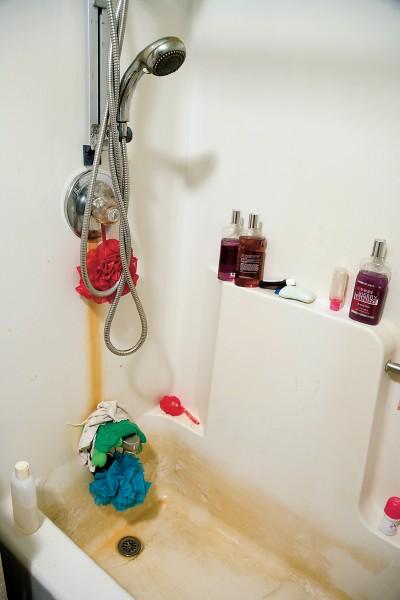
Lambert and her neighbors aren’t eager to single out company names. Some residents are quick to say they aren’t coal-bashing. A teacher says coal companies do a lot for her school—fixing up parking lots, supplying computers, and giving out holiday gift certificates for staff. She doesn’t want trouble. “In coal country, they will take you to court and sue you good if you talk about their business in a slanderous way,” says one resident.
Terry Keith, whose house is ten minutes from Lambert’s, is worried about her grandchildren. She lives with her son and daughter-in-law. She babysits their two-year-old triplets every day while they’re at work. Before she knew better, she was using tap water in their formula. She still cooks and does dishes with the water because it costs too much not to.
Someone from the local health department came to test Keith’s water but checked only for coliform bacteria and E. coli; testing for metals is too expensive. Keith says the woman who came over told her she wouldn’t bathe babies in the water. “What are we supposed to do?” says Keith, who lost her husband in a mining accident 20 years ago.
The Boone County Commission, a government agency, is supplying city water at a community center about ten miles from Keith’s house; residents bring their own jugs. She says she can’t just pack up the triplets and drive 30 minutes for water. What about the elderly, she asks, and the people who can’t afford cars?
When they met with the local water company in January, some of the Prenter residents were told it could take at least three years to get access to city water. Lambert held up her water sample and asked a company employee if he’d like a drink.
Lambert and her neighbors waited months to hear from the DEP. The testing found no direct link between coal mining and their water problems.
DEP secretary Randy Huffman visited Lambert’s home in May. He brought someone from the Department of Health and Human Resources with him.
“In their frustration, they are looking at the state and saying, ‘How can you not help us when you know we have a problem and you know there’s coal mining close by and you know there’s underground injection close by?’ ” he says. “We’re not finished with our investigation. . . . We’re actually trying to make that connection.”
If they keep looking, Lambert says, they’ll find something.
A friend of Lambert’s, Patty Sebok, gives residents tips on writing letters to politicians and newspaper editors. Check your grammar and punctuation, Sebok says, and tell your story.
“I read that there is a lot of money appropriated for water projects. I pray—and I do mean pray—that they see it in their heart to send some of it our way,” Lambert wrote to Congressman Nick Rahall. “It is getting worse every day.”
Rahall, whose office said he was unavailable for an interview for this article, replied to Lambert that he had contacted the West Virginia Public Service Commission and the Bureau of Public Health on her behalf. Lambert says she got a similar response from Senator Robert Byrd, who said, “Coal turns on the lights in the Capitol!” during a 1999 rally on the Hill after a court ruling against mountaintop mining.
George Davis of Marshall University says politicians in West Virginia have always worked hard to make sure mountaintop-mining regulations weren’t strengthened any more than they had to be. “It’s a balancing act between doing what’s right for the environment and the people who live there and for economic development,” says Davis. “Coal is still the biggest game in town. They’re not going to do anything that’s going to in any way hamper that industry.”
That doesn’t mean politicians don’t care about the environment. Congressman Rahall spearheaded legislation to expand the Abandoned Mine Reclamation program, which helps protect citizens affected by abandoned sites. Senator Jay Rockefeller, whose staff said he was unavailable for an interview, is pushing for federal investments in research on and commercial deployment of carbon capture and sequestration, technology that would allow coal-fired power plants to inject CO2 underground rather than release it into the atmosphere.
But if they want to be reelected, Davis says, they’ll do what’s best for coal.
“They’re all going to say, ‘We want the Clean Water Act enforced’ or ‘We want the toughest pollution regulations possible,’ ” says Davis. “But when an instance comes up where they have to make the decision, are we going to listen to the citizens who say their water’s polluted or the businesses that say they’re providing jobs for West Virginia? More often than not, the latter win.”
Lambert and her neighbors think the situation is simple: Their water is contaminated, and people are sick. She recently sent out an e-mail that included an invitation to her congressman: “Dear Mr. Rahall, I would like to invite you to dinner at my home. I am cooking a wonderful meal with our well water.” When Bobby Mitchell went door to door, 20 of 35 people using wells reported digestive problems—cramping, internal bleeding, intestinal disease. One man said a doctor found arsenic in his blood and asked if the man’s wife could be poisoning him. Mitchell says a nurse is looking into the number of miscarriages in the area.
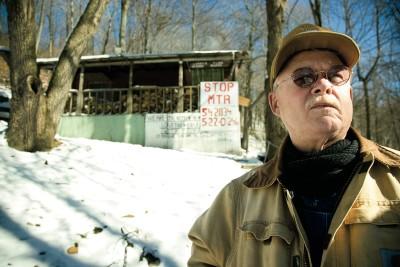
But a direct link is hard to prove. West Virginia isn’t known for its healthy habits: The state has the nation’s second-highest obesity and smoking rates. And lots of people have spent years in the mines. When epidemiologists research health-related “clusters”—cases suspected of being related—they often find that the apparent association disappears.
“It’s never quite as simple as it looks,” says Tee Guidotti, chair of George Washington University’s Department of Environmental and Occupational Health. “There are very often underlying risk factors that are at play in the community, all of which have to be examined.”
Patty Sebok didn’t realize how much went into an epidemiological study when she asked Celeste Monforton, a research associate in public health at GW, for help. Monforton, who used to work in mine safety, was sympathetic to Sebok’s struggle. She started asking questions: How long had the people with brain tumors lived on their property? What type of tumors did they have? When were they diagnosed?
She’d give Sebok guidance, she said, but she couldn’t do a study herself. She didn’t have the resources—including a hydrologist, geologist, and statistician. She’d need to investigate the water in other mining communities, too, for comparison.
“I’d love to have the money to really get to the bottom of it,” she says. “The question is who would pay it.”
What Happened to the Mountains?
Night in the coal fields is pitch-black. To get to Maria Gunnoe’s house, Chuck Nelson pulls into a long, muddy drive and parks when the road ends at a creek. He walks across a bridge and follows the train tracks before walking up a hill to a small ranch-style house.
At night the mountains loom in silence, and every day there are earth-shaking blasts over the ridge line. Since the coal companies began mountaintop mining several years ago, Gunnoe, the 39-year-old activist, decided she wasn’t going to sit back and allow the destruction. She was proud that her father and grandfather were coal miners, but this kind of mining was different—they were taking the tops of mountains off, not digging underneath them.
Gunnoe has testified in court against the practice despite physical threats from men working at nearby mining sites. “It’s bad because her kids got to go to school around here,” says Nelson.
A friend of Gunnoe’s 12-year-old daughter was forbidden to visit their house. In coal country, Gunnoe and Nelson are considered “extremists.” For protection, Coal River Mountain Watch, one of the groups Nelson works with, keeps its office doors locked if someone is working alone.
In Gunnoe’s garage, an old TV set plays live video feeds of her house. One of Gunnoe’s dogs was shot by a disgruntled miner, she believes.
“Right here is an aerial photo of my home,” she says, pointing to a picture of a small house tucked into a hillside. Over the ridge, there are no trees, just a moonscape—holes in the earth as far as the eye can see: “That was called Island Creek Mountain.” She points to a ridge line where she and fellow activists stopped one valley from being filled. But Gunnoe can’t keep up—she says she saw about 40 mountaintop-mining permits listed in the local paper last week.
“This place was paradise,” she says. “They’ve turned it into hell.”
Maria Gunnoe’s property has been flooded nine times since coal companies started blasting near her home in 2000. In 2003, the tiny creek that flows down from the mountains grew into a 70-foot-wide wall of water.
“It sounded like a train coming with ten more behind it,” she says.
In heavy rains, Gunnoe and her family go to sleep dressed. The time it takes to put on shoes can make a difference between life and death. During the 2003 flood, the Gunnoe family was trapped in the house for 15 hours. When the water subsided, they found their front yard had washed away.
Gunnoe has lived in this modest house all her life—she left only to attend college—and her grandfather lived there decades before that. Southern West Virginia has always been prone to floods, but not like this.
After the flood in 2003, Gunnoe followed the stream up the hollow to see where all that water had come from. Close to the stream’s headwaters, her path was newly blocked by a big wall of rock and dirt. “I had no idea what was going on,” she says.
Gunnoe had discovered a valley fill, waste from mountaintop mining that “fills” the space between two mountains. SouthWings, a nonprofit conservation organization, flew her over the mining site. Gunnoe couldn’t believe her eyes. Behind her home, 1,100 acres of mountains had been stripped. She could see the fill and two sediment ponds. “The drainage for this entire hollow is coming off of a mining operation,” she says.
Gunnoe didn’t think the flooding was an act of God, as mine engineers like to say; she believed it was manmade.
Bill Raney, head of the West Virginia Coal Association, says that those who think mountaintop mining is destroying the environment need to take a closer look.
“The fellows that are doing that kind of mining grew up in the vicinity of where they’re mining—they’re not going to do anything to affect the streams they fished in as young men,” Raney says. “They’re certainly not going to do anything to affect the mountains they hunted on.”
Raney says people don’t understand that coal companies spend months doing geological testing and collecting water data before they mine mountaintops. The problem, he explains, is that environmental groups often publish photographs of active construction sites, instead of reclaimed mountaintops, to draw on people’s emotions.
“What you have to do,” he says, “is look through the operation and say, ‘What is that site going to look like when they finish?’ ”
Raney says that every mining site is reclaimed—a process that starts immediately after coal removal. Some are reforested or revegetated; others become development opportunities—schools, housing, shopping centers—in turn creating jobs.
Some residents want the mountains they’ve always known. And activists such as Gunnoe argue that coal companies can never truly restore the land they’ve mined. Appalachia is one of the most biodiverse regions in the world; the temperate hardwood forest is filled with reptiles, birds, and aquatic insects. According to Ilovemountains.org—a Web site maintained by seven grassroots organizations including Coal River Mountain Watch—when mountains are reclaimed, most sites receive “little more than a spraying of exotic grass seed.”
Raney sees it differently: “It’s somewhere between 1 and 1½ percent of the land mass of West Virginia that’s been disturbed by mining, and all that land is reclaimed. We have more forest land today than we did 20 years ago. We’re getting so much better at reforestation—we’re doing it with a variety of species.”
Raney admits that there are times coal companies make mistakes. He says those are fixed quickly: “The ultimate intent is that when you’re finished mining, you will probably not know it’s been mined—and the water quality will be every bit as good as before.”
Coal companies require a permit authorization from the US Army Corps of Engineers before they can discharge dredge or fill material into US waters. Until 2003, the corps routinely used “nationwide 21” permits, developed by corps headquarters, which are distributed when a proposed project is expected to have a minimal impact on the environment. Now most surface-mining operations require individual permits; some smaller projects, with less of an environmental effect, still receive nationwide 21 permits.
Jim Hecker, an attorney with DC-based Public Justice, was shocked when he saw what was happening with the permitting process in West Virginia in the late 1990s: “They were claiming that these huge mountaintop mines—which cumulatively covered 50 or so square miles, destroyed thousands of acres of forests and hundreds of miles of streams—had no significant impact, which was ridiculous.”
Hecker and a young lawyer in West Virginia, Joe Lovett, began challenging the permitting process in US District Court—a legal fight detailed in Michael Shnayerson’s Coal River—charging that dumping mining waste into streams was a violation of the Clean Water Act. The lawyers said companies were given permits to fill valleys without preparing a thorough environmental-impact statement. Hecker remembers a deposition in which a permit supervisor testified that his agency had processed thousands of permits for the industry—and not one surface-mining permit was denied.
Hecker discovered what Maria Gunnoe already knew: It was hard to stop a coal company in West Virginia.
Says Hecker: “Except for former secretary of state Ken Hechler, we have not had a single elected individual in West Virginia support our case in the last decade.”
The courts have handed some victories to Hecker and Lovett. The duo stopped a permit for the largest mine proposed in the state, a 5,000-acre tract that would have filled several miles of streams. The EPA and the Army Corps of Engineers volunteered to conduct a thorough environmental-impact study of mountaintop mining as part of a settlement agreement in a permit-related lawsuit. The lawyers have made it harder for coal companies to get large-scale mining permits.
But the industry has flexed its muscle in return. Its lawyers don’t have to think twice about an appeal, making it easy to exhaust a nonprofit attorney’s budget. Appeals go to the conservative Fourth Circuit Court in Richmond, where many of Hecker and Lovett’s favorable rulings have been reversed. Several judges on the Fourth Circuit have had to recuse themselves because of ties to the coal industry.
Some residents say Don Blankenship, the CEO of Massey Energy—the largest coal producer in Central Appalachia—is more powerful than the state’s governor. After rulings unfavorable to the industry a few years ago, Blankenship helped fund a lawyer’s campaign to unseat a judge who’d often ruled against him. Blankenship’s candidate won.
The coal industry gave more than $380,000 to George W. Bush’s presidential campaigns, according to the Center for Responsive Politics. Before the environmental-impact statement on mountaintop mining was released, Hecker says, the administration tinkered with it.
“There’s a lot of good science in the statement,” says Hecker. “But none of the science worked its way into the recommendations and conclusions. Unfortunately, it was totally corrupted by the Bush administration, who took it over and turned it into a document to streamline permitting rather than one controlling environmental damage.”
Valley fills are a part of mountaintop mining. If you blast apart a mountain, you need a place to put the dirt. Geologist Alan Stagg says that if valley fills are constructed correctly, they’re engineering marvels that filter rainwater into terraces, slowing down its movement.
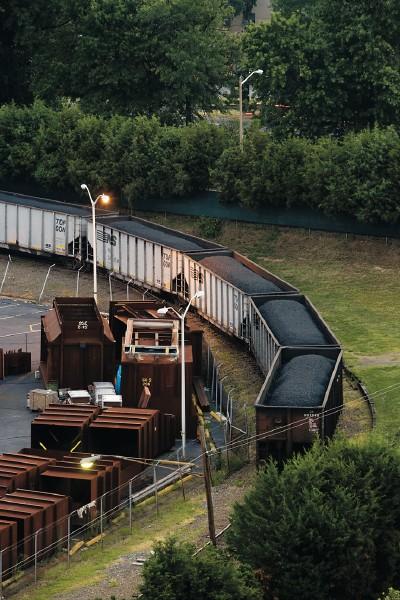
But valley fills are worrisome to some residents. Above Maria Gunnoe’s home are two sediment ponds, standard wastewater sites used in mountaintop mining. The ponds are formed when a dam cuts off a stream and collects the water before sending it downstream. Waste sinks to the bottom before the water is flushed out—in Gunnoe’s case, she says, down the creek in front of her house. A heavy rain may fill a sediment pond higher than capacity and cause it to overflow.
When she was a kid, Gunnoe would drink straight from the creek in front of her house. Today she says she sometimes sees murky black water flow by.
The EPA says in its environmental assessment of mountaintop mining that “mining-related flooding issues were generally found to be the result of problems associated with implementation and maintenance of the approved mining plan and not the mine plan itself.” In other words, valley fills work as long as they’re done correctly.
Who makes sure valley fills are done in accordance with surface-mining laws? West Virginia’s Department of Environmental Protection—which admitted in January that a computer glitch had prevented the department from receiving coal companies’ discharge monitoring reports for five years. In that period, Massey Energy had violated the Clean Water Act 4,100 times. The company had been discharging elements into rivers and streams at levels that violated the act.
“The state just stopped enforcing the Clean Water Act for five years,” says Hecker.
The EPA stepped in, fining Massey $20 million in January, the largest civil penalty for wastewater-discharge permit violations in the EPA’s history. Massey also promised to spend $10 million to enact safety measures so such violations wouldn’t happen again.
As of mid-July, Massey stock was trading at more than $82 a share—up from nearly $36 a share at the end of 2007. The company produced more than $2.4 billion in total revenue last year.
Hecker and Lovett decided early on that the only way to stop mountaintop mining was to stop valley fills. In March 2007, working with attorneys at DC’s Earthjustice law firm, they won a victory. US District judge Robert Chambers ruled that the Army Corps of Engineers’ method for issuing permits for valley fills violated the Clean Water Act. The corps had argued that if you erased a mile of a stream, you could resurrect it elsewhere. Chambers ruled there was little evidence to support that theory. In October, the case was appealed to the Fourth Circuit in Richmond. An expected May argument was postponed until September.
If Chambers’s ruling is upheld, the Army Corps of Engineers would have to apply stricter standards to protect the environment from stream filling, which could mean fewer valley fills.
Maria Gunnoe, who is involved in the suit, won’t be able to erase the fill in her hollow, but she can rest knowing that no more mountains will be destroyed.
“An elder in my community was a veteran of World War II,” she says. “He tells the story of the pilot that dropped the bomb from the Enola Gay. He says the pilot looked back and said: ‘Oh, my God—look at what we’ve done.’ Well, when the politicians look back on what they’ve allowed to happen to the state of West Virginia, they’re going to look at this place and say, ‘Oh, my God—look at what we’ve done.’ ”
Taking the Fight to Washington
Chuck Nelson is walking near the US Capitol on a rainy day in April, wearing his West Virginia baseball cap. He’s in DC for Mountaintop Removal Week, when about 100 people from around the country gather to lobby on the Hill. They wear pins with slogans such as stop slurry injection and carry photos of the destruction in Appalachia.
“The decisions that control our life are made right here,” Nelson says. “It makes me a little angry. They have the ability to change things, and they’re not.”
He’s hoping to help find more cosponsors for the Clean Water Protection Act, which was introduced in the House of Representatives last May. The bill would amend the Clean Water Act, clarifying that fill material cannot include waste. Coal companies would no longer be allowed legally to pollute waterways. The bill has 146 cosponsors so far but not one from West Virginia.
Nelson, his wife, and a few others have come from a meeting in Senator Robert Byrd’s office, where a framed photo on the wall describes a young Byrd as a “child of the Appalachian coalfields.” Any meeting in Byrd’s office is big: While the senator can’t cosponsor the House bill, he has the power to gather support for it or initiate a companion bill. He’s one of the people residents such as Maria Lambert are always trying to reach.
The senator wasn’t available today, but Nelson spent more than an hour with his legislative director, who allowed only West Virginia residents in the room.
“We get the same answers every time: ‘We’ll talk to Senator Byrd and see if he can do anything about it,’ ” says Nelson. “They know what’s happening. It’s just that they’re buddying up with the coal industry to let them mine the cheapest way.”
Nelson says he told Byrd’s aide that residents in the Prenter area had well water that looked like coffee—he didn’t bring a sample because he didn’t think it would get through security—and that people were dying.
“He’s wanting to know, ‘What can we do to get these people clean drinking water?’ ” Nelson says. “It’s simple: Quit polluting our water source.”
Later he finds himself explaining why West Virginians need help from other parts of the country. “You have to understand how West Virginia is,” Nelson says. “The industry runs our state.”
Maria Lambert remembers being overwhelmed with emotion when she was a little girl and the state song, “The West Virginia Hills,” came on. She also loved hearing “America the Beautiful.” That was when she thought she was living in the perfect place—when kids played in the creek and gardens grew. That was when the mountains were an escape.
When she’s asked why she doesn’t move away, why she stays in a place that’s causing her so much grief, tears fill Lambert’s eyes. “This is my home,” she says. “It’s where I was born.”
She’s traveled as far west as Colorado and as far north as Maine, but she and her husband have never found a place to which they’ve wanted to move. And they’ve never felt they should have to. “Why should we leave so they can come in here and destroy everything our families have worked for our whole lives?” she says.
Nelson says the connection between the people and the land in West Virginia is something not everyone can understand. Citizens recently fought to have the state’s welcome message changed from “Open for Business”—a phrase that Governor Joe Manchin started using on highway signs a few years ago—back to “Wild and Wonderful.” A billboard on a mountain road reads:
In God’s hands are the depths of earth
and the mountain peaks also belong to God.
One of Nelson’s friends, Larry Gibson, owns 50 acres that sit on 39 seams of coal. The land is worth millions, he says, but he won’t sell. He lives in a tiny solar-powered cabin at the top of his mountain with no running water. His family has been there for a century—relatives are buried in the soil.
“We’ll get you off this mountain,” he’s been told. “We’ll give you prosperity.”
There are things, the man says, that are too precious to be bought.
This article first appeared in the September 2008 issue of The Washingtonian. For more articles like it, click here.

